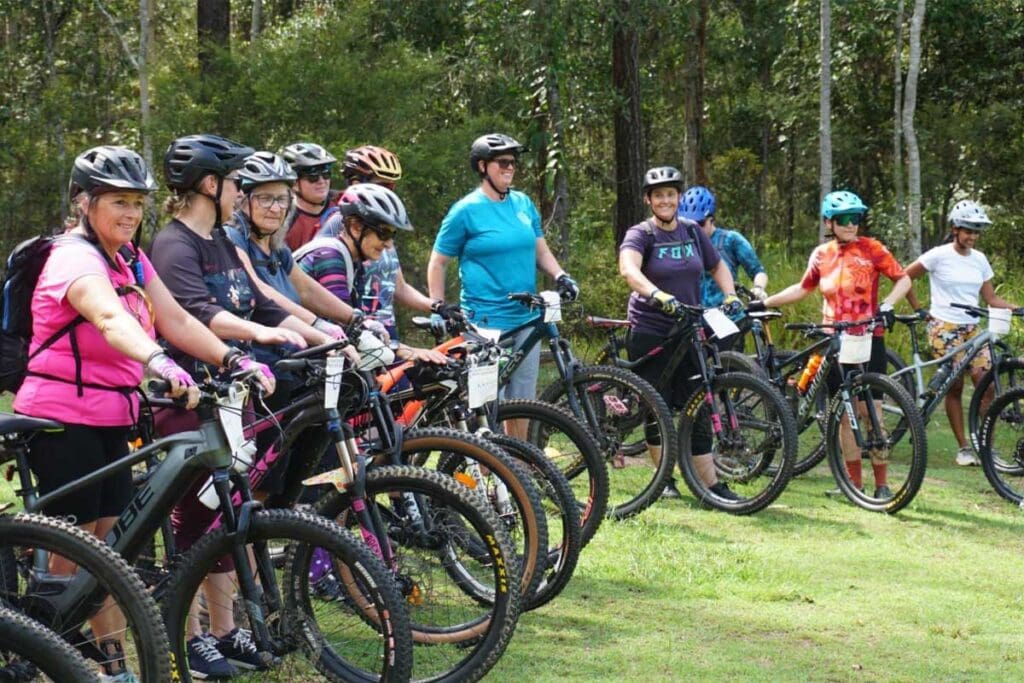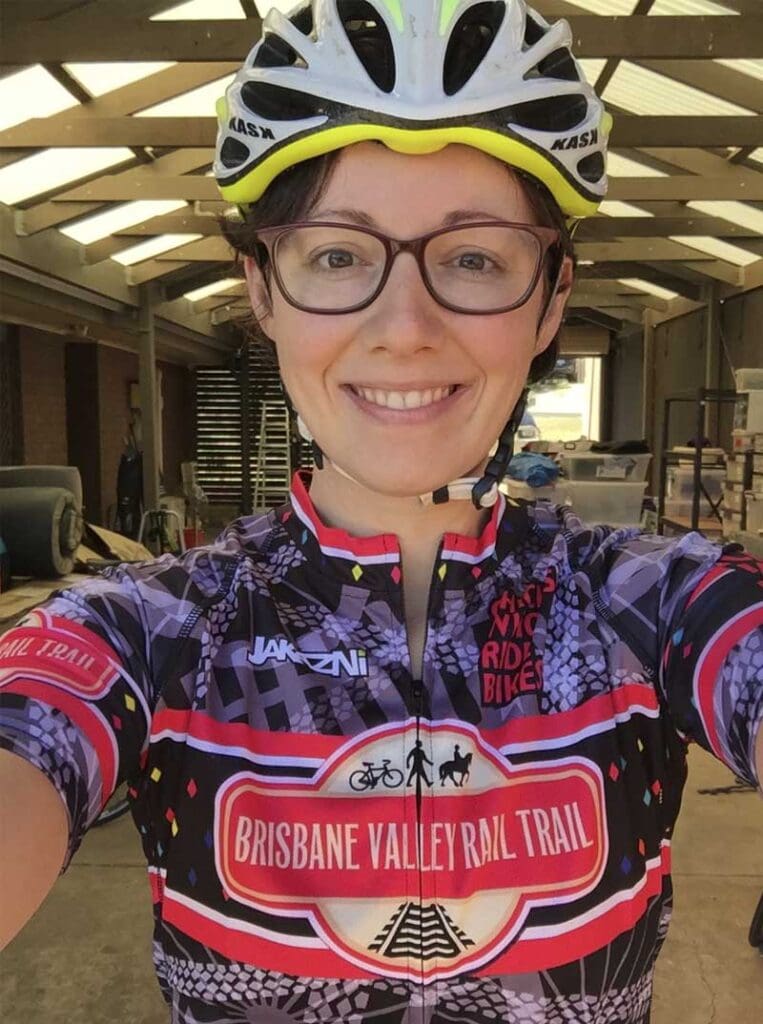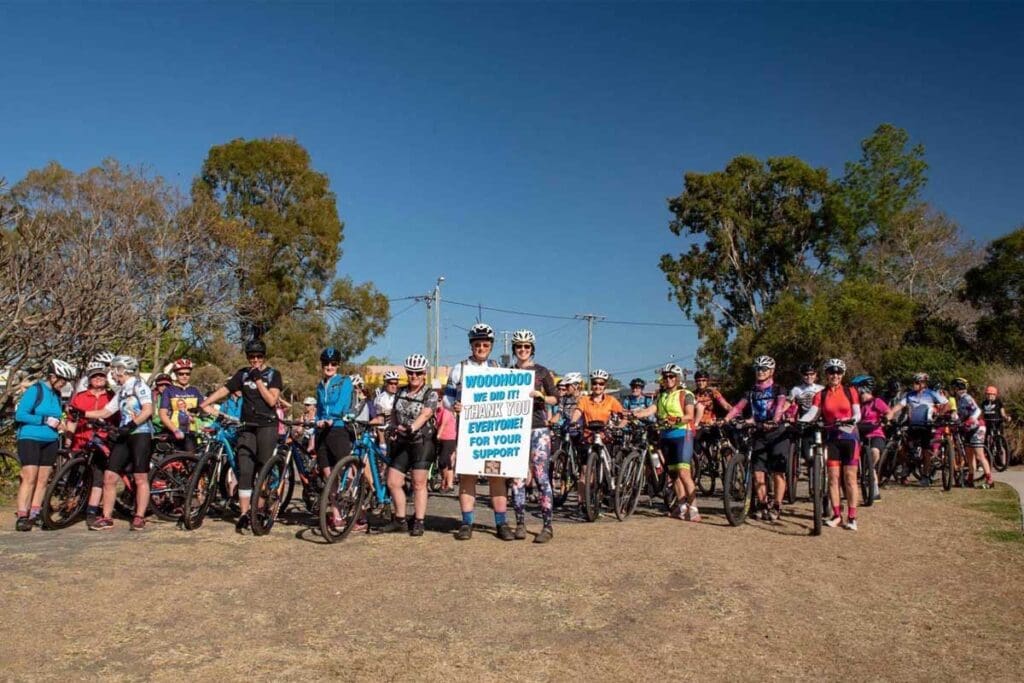Life-Changing Lessons as Chicks Turn 10

Brisbane, Queensland
A leading movement to encourage more Australian women to ride bikes will celebrate its 10 anniversary this month.
Chicks Who Ride Bikes has attracted 23,000 members since it was established on 15 April 2013, as a way for founder Jordana Blackman to foster her own newfound love of cycling.
Recovering from cancer and looking for social connections after recently moving to Brisbane, Jordana started a Chicks Who Ride Bikes Facebook page to meet other women who ride. It swiftly swelled to 500 members in its first year, started hosting workshops to teach riding and maintenance skills and now has CWRB devotees in many parts of Australia.
Jordana says the secret of the group’s success has been to focus on the absolute fundamentals of cycling. It doesn’t assume new members have any knowledge of riding or bike maintenance or a capacity to ride what other cycle advocacy groups consider to be a beginner’s distance.
“There are really only a few objections and concerns women typically have about cycling. Once you’ve overcome those objections and set up a way to bypass them, it’s very easy to get them riding.”
“Women were attracted to the group by its atmosphere of ‘no lycra necessary, every woman is welcome’,” she said.
“It doesn’t matter if you’re on a bike from BigW or you’re on the latest S Works, just come as you are.”
However, Jordana says the past decade has also taught her a lot about overcoming the obstacles to women starting cycling, and tapping into the aspects that inspire them.
“I’ve learnt that there are really only a few objections and concerns women typically have about cycling. Once you’ve overcome those objections and set up a way to bypass them, it’s very easy to get them riding.”
She says the trick is to diffuse the tendency for a lot of women to overthink things.
“They’ll think ‘there’s this great thing I’d like to be involved with, but what if I get a flat tyre? I don’t know anything about bikes. Everyone else knows how to do it. I’ll be useless. I just won’t go’.
“There are a few things that lead to the same place of ‘oh I just won’t go’.
“We use a lot of imagery of middle-aged women who carry weight and women joining in our events who you might not think of as traditional athletes.”
“We can intercept those things. One of the first things we do is an ABCD bike check and help understand how to change a tyre. Once they see it’s not rocket science and they can do it by themselves, it’s a lot easier to convince them they can do other things too.
“Also, saying no lycra necessary is a must because, in the same way, women will say ‘I’ve seen people out on their bikes in lycra and they are probably all fit and fast and fabulous. I don’t have that. God I’m fat and wouldn’t I look awful. I’m just going to be fat and slow and everyone will laugh at me and I just won’t go’.
“We’ve had a lot of success by preempting that. We use a lot of imagery of middle-aged women who carry weight and women joining in our events who you might not think of as traditional athletes.
“That helps women to identify and connect. Women say ‘oh she’s in her 50s and she’s doing it and seems to know what she’s doing. I think I can do that’.”
Jordana says it’s shifting the train of thought from ‘oh, I don’t belong here. I’m going to be the odd one out and everyone is going to laugh at me’ to ‘I feel I could do that if she’s doing it’.
“It’s just changing the perspective to help them identify with cycling, rather than trying to find reasons to not show up – which is the main reason only two in five women are sufficiently active.
“Women in that age bracket would have grown up at a time when boys did woodwork and metalwork and the girls did sewing and cooking classes. They weren’t encouraged to tinker with machinery and discover how things work.”
“Our average age is 46, which I think is pretty good for women to be starting something new. The vast majority, maybe 80% or more, would be non-typical athletes, wonderful middle-aged women. It really has become a haven for women who want to give this bike thing a go but don’t feel they fit in anywhere else.
“It doesn’t matter if you’re new to Australia, if your English isn’t that good, or if you’re riding a piece of crap bike from a department store. It’s just a great way to connect and build your own community.
“I’m not saying anyone in the sport of cycling is doing a bad job, but that women tend to self-exclude very quickly because we don’t want to be the fattest or the slowest and have people laugh at us; or be the only one who doesn’t know how to do XYZ.
“Women in that age bracket would have grown up at a time when boys did woodwork and metalwork and the girls did sewing and cooking classes. They weren’t encouraged to tinker with machinery and discover how things work.
“So we say ‘it’s totally fine you don’t understand how these things work. Why would you if this hasn’t been an interest of yours or part of your life until now’. At the same time, we say ‘you absolutely can do this because it’s not rocket science’.
“Those lightbulb moments for newcomers make everything worth it because it’s self confidence that can be difficult to get for middle-aged women.
“It’s great when women can see other women who now have more time for themselves, whether it’s because they have grown-up children, and are wondering how they are going to spend it.”
In addition, the spectrum of group rides offered by CWRB includes extremely short distances to “set the scene”.

“Some women might only ride 5km when they are new and probably spend more time having coffee afterwards that actually riding. That’s the sort of stuff that really isn’t offered elsewhere in any structured way,” Jordana said.
“I love that our members feel safe enough with our group to ask the most basic questions, like the need to pump up bike tyres or how to change gears, without being judged.”
“We all have to start somewhere and build up slowly. We offer real grass roots rides from day one, where you get shown where your brakes are, how to use your gears.
“With a lot of larger organisations, their short ride might be 25km which, for a lot of women who get involved with us, is already off-putting.
“There’s a misconception or a knowledge gap in the industry about an assumed level of competence and fitness.
“Beyond the ability to stay upright, we don’t assume they necessarily know how to do anything.
“I love that our members feel safe enough with our group to ask the most basic questions, like the need to pump up bike tyres or how to change gears, without being judged. We must be providing a great atmosphere.”
Jordana said she had a similar introduction to cycling as an adult because, as a child in Florida, she didn’t grow up around bikes.
She took up cycling at the age of 25, while living in Melbourne and as a survivor of cancer.
“I had cancer in 2012 and was treated at Melbourne’s Peter McCallum Cancer Centre. When everything was all clear, I was in a café and there was a flier for the Ride to Conquer Cancer, benefitting the centre.
“I had this feeling ‘aren’t I so lucky I live in a place where we essentially have free public health care and the centre’s staff were so wonderful. I’d love to do this and raise money’.
“Step one was learn how to ride a bike.”
Coincidentally, during the week of her cancer diagnosis, she’d met Irish expat and experienced cyclist Joe Mullan, who became her boyfriend and, eventually, her husband.
“Buying a bike was one of the best days of my life. I made every possible mistake but it was a sense of great freedom. Probably the way a kid feels when they get their first bike,” she said.
Jordana and Joe moved to Brisbane in 2013 and she created the CWRB Facebook page as a way to further her passion for cycling and build a circle of friends.
“I’d tried riding with my husband a couple of times, with disastrous results. He’s a very strong cyclists, both on and off road, and I always felt he was having to waiting for me and maybe resenting being on the ride,” she said.
“I’m sure he’d say that’s not how he felt, but it’s how I felt.
“Cycling for me has always been a way to connect with people and explore. I didn’t want to have a focus on the number of watts or kilometres.
“Chicks Who Ride Bikes stemmed from me not being a competitively inclined rider. The club model never really worked for me.
“It really was borne out of wanting something specifically for women who want to connect for rides, whether that’s to cycle to work, to the park with kids or for fitness.
“Whenever I passed a woman on the trails or out on the road, or at a café, I’d just tap them on a shoulder, mention the group on Facebook and suggest we connect and go ride.
“I was so excited about my newfound hobby and the community we’d created.”
Jordana found volunteers to head outpost groups in the Sunshine Coast and Gold Coast, while she continued to focus on the Brisbane group, which now has around 4,000 members.
In addition, CWRB now has chapters in Melbourne and Adelaide.
Potential Revealed
Jordana said she first realised the full potential of CWRB when Bicycle Queensland sought her advice on promoting women’s cycling.
“We had had 30 women enter the Brisbane to Gold Coast ride in 2013 or 2014 – one of the first years we did it as a group,” she said.
“Bicycle Queensland was like ‘oh my God, we’ve never had that many women sign up at once’.
“Then in 2015, Bicycle Queensland officially asked us for advice on how to boost female participation at their events. When a group like that, which has 60,000-plus members, asks us for advice, it occurred to me that we had the key to something.
“I’d just been following my nose to start with – what I wanted when I started riding, and what I didn’t know and found awkward.
“When BQ approach us, I realised those things might be gaps that exist everywhere and there’s no reason why our approach couldn’t be scaleable everywhere.”
Chicks App
Jordana launched a CWRB app last year, to better reach its members and more effectively analyse its advocacy efforts.
“The app provides greater opportunities than Facebook to analyse trends, conversations and data,” she said.
“It identifies how often particular questions are asked and helps determine things the group should focus on: is it a skills session we should run, is this a question we should put funding into to develop a YouTube series?
“We own and can analyse the data in any way we see fit.”
She said that analysis has provided greater insight to the mindsets of women as they become more experienced cyclists.
“The number one lesson from that data is there’s still a lot of women who classify themselves as beginners, who really are not.
“While they might not feel confident to call themselves intermediate or advanced, they are successfully participating at skill sessions for riders at that level.
“That was surprising for me and indicates there’s still a gap.”
Jordana said that has taught her how to target workshops and other educational activities for experienced female riders who still consider themselves as beginners.
“They are still progressing through participating and practise and that’s what matters, over and above what they call themselves.
“If we had to choose an avatar for the typical CWRB member – who sits midway along the spectrum from absolute beginner to our most experienced members – she would be mid-40s, able to ride 40-50km comfortably on the road, or 15-20km on a mountain bike, and maybe dabbling in triathlon as a real milestone in her level of confidence.”

Grant Assistance
CWRB got a grant from Queensland’s Department of Transport and Main Roads to create the app, as a focus on getting more women riding bikes.
“We had $20,000 to develop a prototype and had many app developers hang up when we mentioned our budget,” she said.
“However, Brisbane company The Famous Group partnered with us to develop the app. Now we’ve been able to reward them with six figures of investment, following a second grant from the Queensland Department of Tourism, Innovation and Sport, after we went to them with the prototype.”
As part of the collaboration with The Famous Group, three new features have been developed for the app and will be rolled out during this year.
Anniversary Celebrations
CWRB will hold a series of rides over Easter to celebrate the anniversary and will upload a special story to its social media channels on 15th April.
In addition, Jordana was reunited with the Brisbane members for a skills workshop last month.
Jordana and Joe moved to Adelaide in 2016 but returned to the CWRB heartland to run an offroad riding clinic in Brisbane on 26th March.
“That is a new passion of mine, to get women skilled so they feel they can mountain bike,” she said.
“March 26 is also Purple Day, which raises awareness about epilepsy and is a day of fundraising for Epilepsy Action Australia.
“It’s a cause I’m passionate about, having experienced a traumatic brain injury and a series of seizures. I very much empathise with people who live with the condition.”
Jordana suffered a traumatic brain injury in a bike accident in 2020 and had a series of seizures last year as a result.
“I don’t want to scare off people but it’s one of those things that can happen: mountain biking, bike versus tree and rock.
“I was an outpatient at Hampsted Rehabilitation Centre in Adelaide for six months. About a year and a half later, I caught a flu in Thailand and it triggered eight weeks of daily seizures, all linked to what they call software problems from the injury.
“I now have medication to control everything, but it was so distressing for me, my husband and the people who were around me.
“There are people live like this throughout their lives and it’s so unpredictable.”
Further information about CWRB is available on the group’s website, by joining its Facebook Marketplace or visiting its Instagram page.
